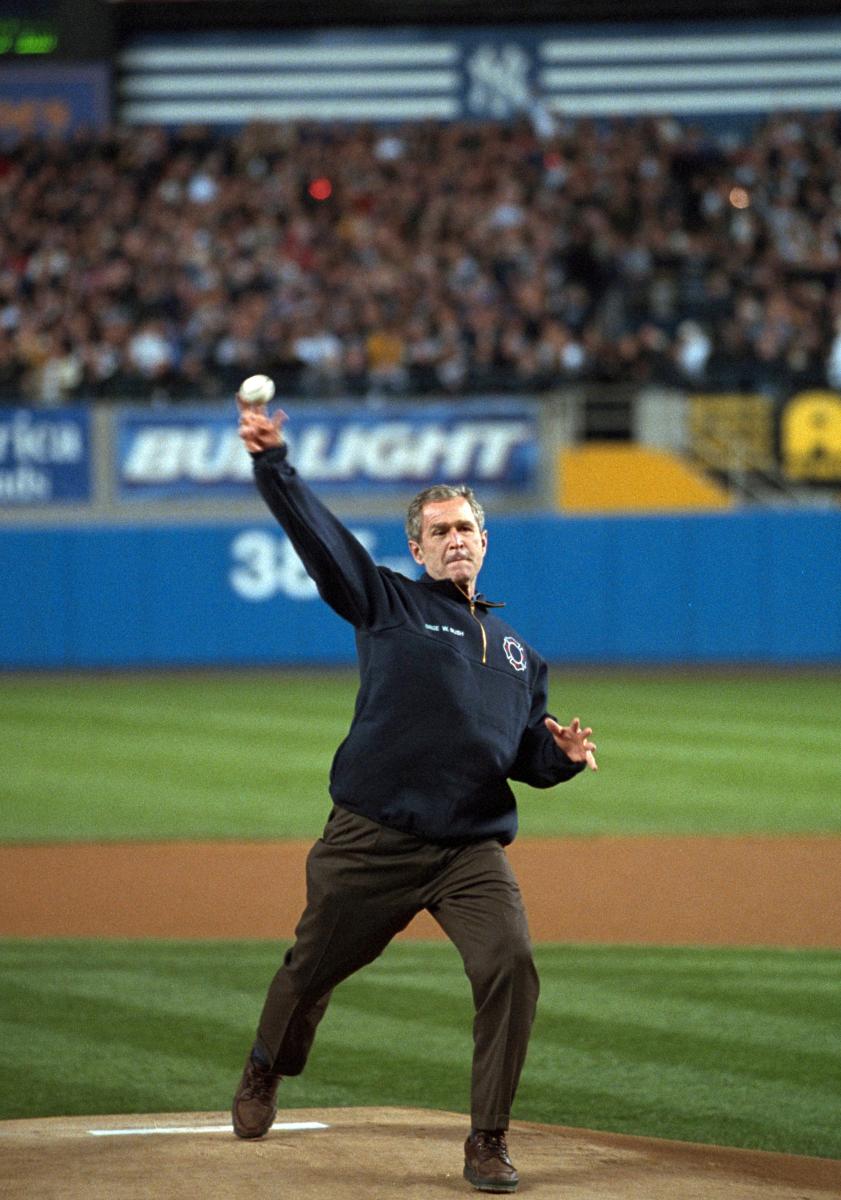
First Pitch Showcased in All American Exhibit Demonstrates How Sports Helped Unite Nation After 9/11
By Angela Tudico | National Archives News

NEW YORK, September 9, 2022 — When visitors walk into All American: The Power of Sports, the new exhibit opening at the National Archives Museum in Washington, DC, on September 16, they will be greeted with a familiar sight: images of a ceremonial first pitch at a baseball game.
But this was not just any baseball game—it was Game 3 of the World Series on October 30, 2001, at Yankee Stadium in the Bronx, and it was the month after the 9/11 terrorist attack on the World Trade Center several miles and one borough away, in Manhattan.
Nearly 21 years later, the photo of President George W. Bush throwing out that first pitch remains a symbol of a step toward a return to normalcy following the attacks, both for New York City and the United States, and of Americans coming together.
The crowd cheered the President as he walked to the pitcher's mound, then chanted “USA!” when the pitch made it directly over the plate. Exhibit Curator Alice Kamps detailed the scene at Yankee Stadium that night: “The crowd's response was spontaneous, unscripted, and heartfelt. People there, including the President, describe it as one of the most powerful things they've ever experienced.”
The “Power to Unite” section of All American explores how sports bring people together, so it is fitting that the first pitch appears there.
“I chose to lead with the post-9/11 World Series pitch because it's such a dramatic example of the power of sports to inspire feelings of patriotism and unity,” Kamps said. “You've got the President there, involved in the 100-year-old tradition of throwing out a ceremonial pitch at an opening game, yet it's extraordinary because of the crisis he's trying to lead the country through and the trauma that the nation experienced. And he's putting himself in potentially grave danger by appearing on that open field.”
After the terrorist attacks on the World Trade Center, the Pentagon, and Shanksville, Pennsylvania, the United States partly shut down—for days, civilian air traffic stopped and Broadway shows went dark. Major League Baseball ceased play for an entire week.
Baseball resumed in New York City 10 days after the attacks, when the Atlanta Braves played the New York Mets at Shea Stadium. That night, many of the players from both teams wore FDNY and NYPD baseball caps in honor of the first responders who risked their lives during the city’s rescue efforts.
President George W. Bush threw out the World Series Game 3 first pitch wearing a fleece pullover jacket given to him by the Fire Department of the City of New York, strengthening the symbolic impact of the ceremonial pitch. That jacket, on loan from the George W. Bush Presidential Library & Museum, will be part of the exhibit as well, giving viewers a more visceral experience beyond photographs of the now-famous pitch.
“Artifacts like the President's jacket hold such power,” Kamps said. “It was there. It touched the President's skin. It was bathed in the sights, sounds, and atmosphere of the day. When we share space with artifacts that literally touched history, we are transported to a different time and place. Photographs give us information, but they don't spark the imagination the way that artifacts can.”
The inclusion of the jacket and other artifacts in the All American exhibit require special care and attention from the National Archives and Records Administration’s (NARA) conservation staff.
“Fortunately, the jacket is in excellent condition and doesn’t require any conservation prior to the exhibition,” explained Exhibits Conservator Dong Eun Kim. “However, the mounting of clothing often requires coordination and collaboration between exhibition staff and the contractors who make the mounts specific to the artifact. Each object must be considered individually, with mounting designs and fabrication that are appropriate to curatorial and preservation perspectives.”
Once installed, these artifacts require careful climate monitoring by conservation staff while on display unique to each type of object, with some requiring their own microclimate.
“My background is in paper conservation, and most of the exhibitions with which NARA is associated are documents, photographs, volumes, and other paper-based materials,” Kim said. “It’s an exciting treat to have an exhibition of such a wide variety of objects here at the National Archives!”
The All American exhibit opens on September 16 and will be on view through January 7, 2024, in the Lawrence F. O’Brien Gallery of the National Archives Museum in Washington, DC. Admission to the National Archives Museum is always free, and reservations are not required.
All American: The Power of Sports is made possible in part by the National Archives Foundation through the generous support of AT&T, AARP, and Mars, Incorporated. Additional support provided by HISTORY® and the Lawrence F. O’Brien Family.
